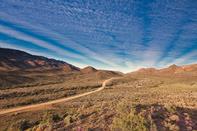Travel back through time into the Great Karoo, a geological wonder world where convoluted shapes carved from sedimentary bedrock offer a window on a prehistoric age. These arid plains were lush wetlands during the existence of the supercontinent of Gondwanaland, and the rugged mountain ranges were shaped by colossal terrestrial forces.

The word ‘Karoo’ comes from the Khoi Karusa, a term referring to a ‘dry and barren thirstland’.
The Great Karoo forms the second largest plateau region outside of Asia. This semi-arid area covers much of the central parts of South Africa, and it is also the most sparsely populated section of the country.
A remarkable diversity of the vegetation thrives within this semi-desert landscape, with biomes covering the full gamut from Karroid and Renosterveld to expanses of mountain fynbos. Numerous bulb species, bizarre succulents, hardy aloe and ancient proteas trees are but a few of the 600-plus species currently flourishing in the Karoo. This landscape is shared by Cape leopard, caracal, baboon, klipspringer and a range of indigenous animals like springbok, kudu, gemsbok, hartebees, eland and wildebeest, as well as key raptor species such as the black eagle and jackal buzzard.
The Great Karoo captivates tourists, researchers and scientists. Archaeologists, anthropologists, botanists, ecologists, geologists, and paleontologists come from across the world to study many aspects of this fascinating dryland. The Karoo offers visitors vast plains, majestic mountains, champagne air and picturesque Karoo towns steeped in history and intrigue.
 The Great Karoo expands over various small towns and places of interest that are sure to entice any traveller. The Karoo Climate is interest...
The Great Karoo expands over various small towns and places of interest that are sure to entice any traveller. The Karoo Climate is interest... More than one town, at different stages of the development of South Africa, has laid claim to being the ‘Capital of the Karoo’. Today, h...
More than one town, at different stages of the development of South Africa, has laid claim to being the ‘Capital of the Karoo’. Today, h... The seemingly endless vastness of the Karoo is an adventurous trip that should be on any local South African’s bucket list. Travelling thr...
The seemingly endless vastness of the Karoo is an adventurous trip that should be on any local South African’s bucket list. Travelling thr... At the same time that the reptiles were creeping out into the evolutionary sunshine, the Karoo Supergroup started forming. It would eventual...
At the same time that the reptiles were creeping out into the evolutionary sunshine, the Karoo Supergroup started forming. It would eventual... The last time I attempted the trip into the thirsty interior of South Africa's Karoo, my ageing pickup refused to co-operate. This time, I c...
The last time I attempted the trip into the thirsty interior of South Africa's Karoo, my ageing pickup refused to co-operate. This time, I c... The farm once named Loneliness is today neither lonely nor merely a farm. The dusty Karoo farming district of which Murraysburg forms the hu...
The farm once named Loneliness is today neither lonely nor merely a farm. The dusty Karoo farming district of which Murraysburg forms the hu...